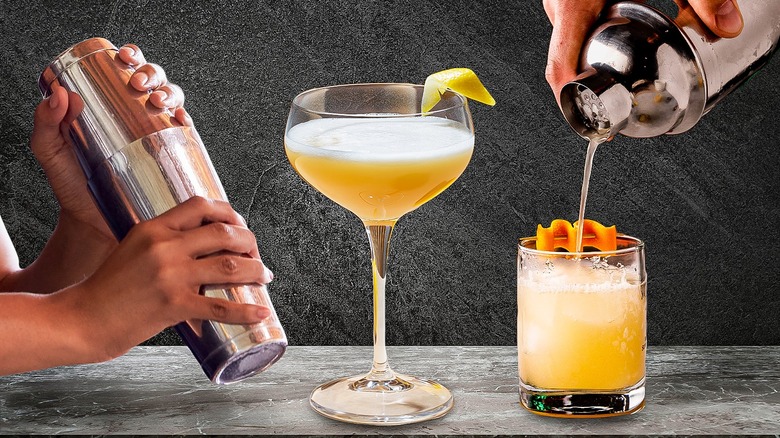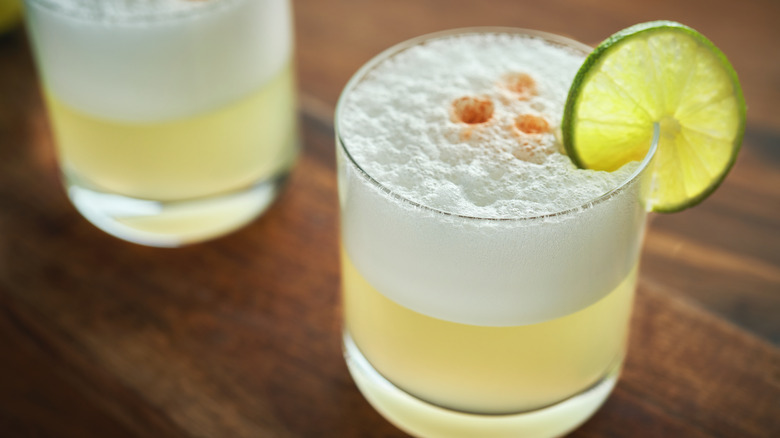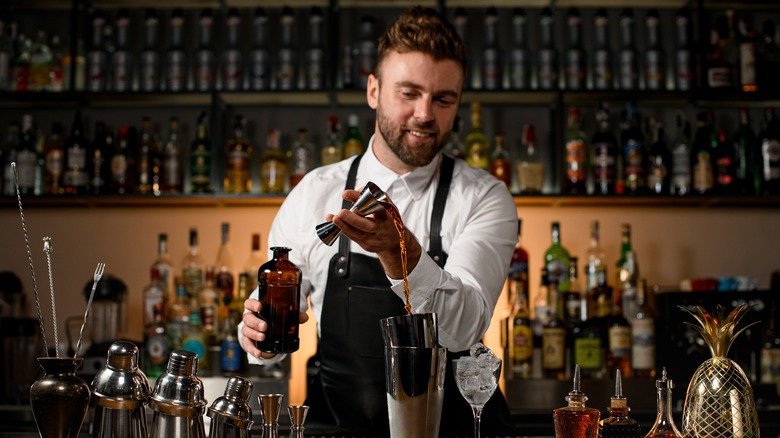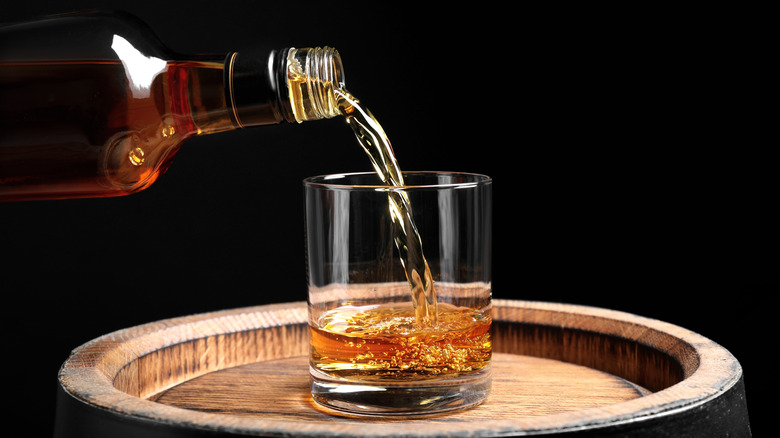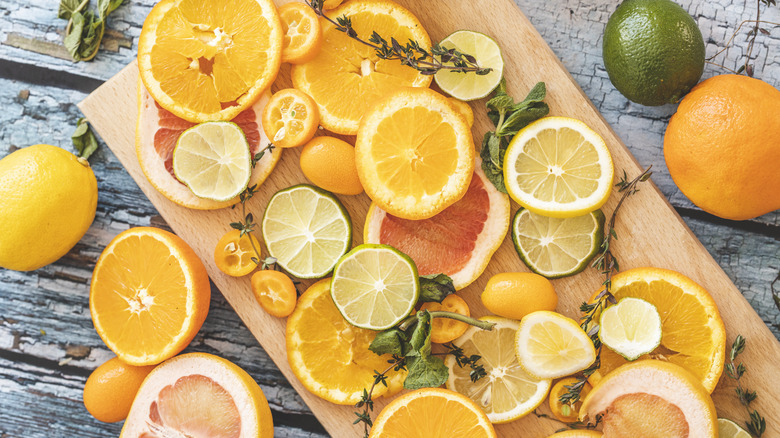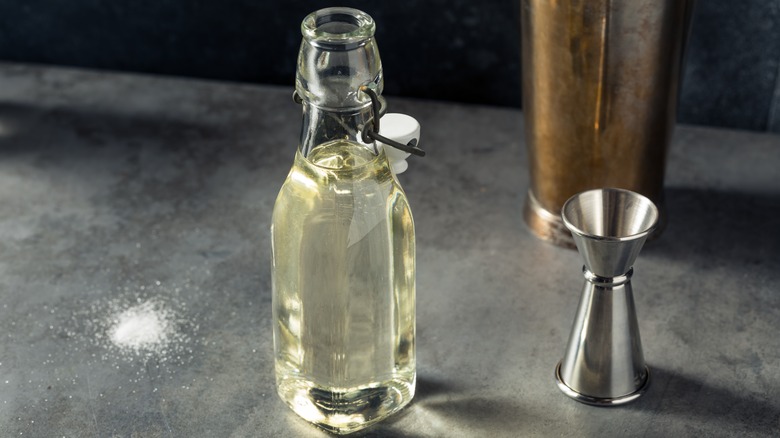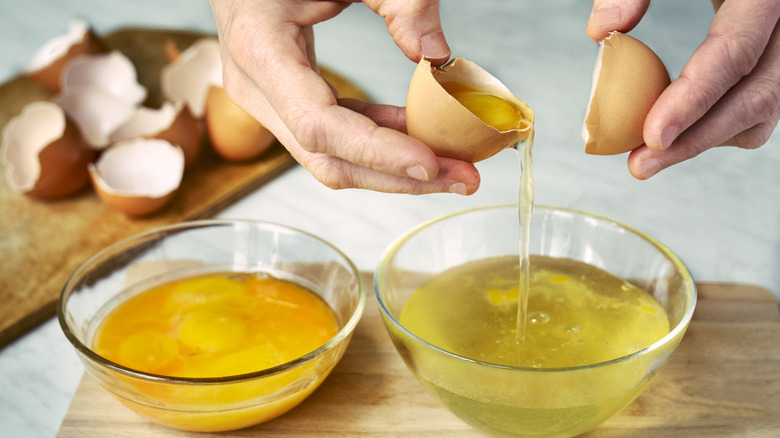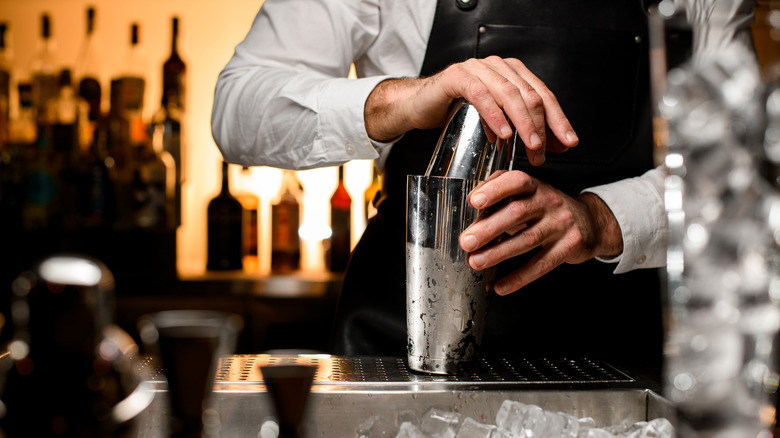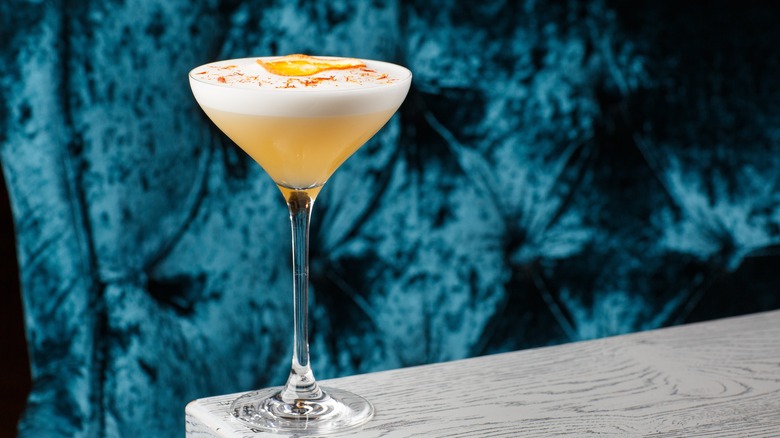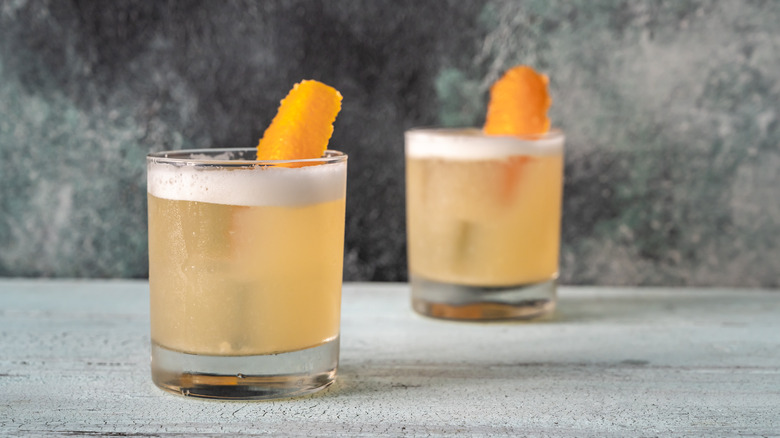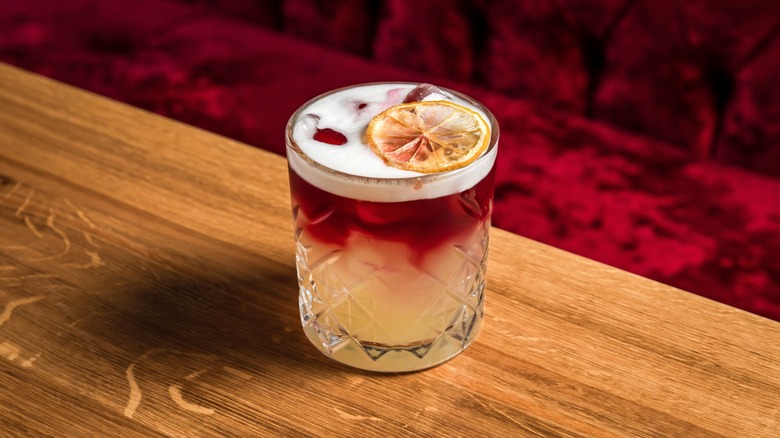9 Tips You Need For Better Whiskey Sours
Being an at-home mixologist doesn't require a bar full of ingredients and a degree in chemistry. In fact, some of the most enjoyable cocktails are the simplest — just a few ingredients, basic tools, and proper technique are all it takes to pour out a pretty good one. Sour cocktails — anything from a margarita or daiquiri to a Penicillin or a whiskey sour — combine three ingredients into cocktail magic. While professional mixologists and home bartenders alike will tweak the ratio to suit their tastes, each will be pretty tasty using the same basic ratio: 3 parts alcohol, 2 parts citrus, and 1 part sweetener.
When it comes to a whiskey sour, that combination balances the ingredients' flavors. Your choice of whiskey will bring anything from bourbon's warmth to rye's spice, while the citrus (usually lemon juice) brings acid and bite. A little sweetness from simple syrup rounds it all out, and you can tweak the ratio to find your own perfect balance.
If you're looking to take your whiskey sour game to the next level, let some master mixologists be your guides. As well as drawing on some personal experience in the industry, we turned to Joe Newton of Root & Flower in Vail, Colorado, and two Death & Co bar managers — Javelle Taft of Death & Co East Village and Matthew Belanger of Death & Co Los Angeles — to share some of the whiskey sour insight they've garnered in their years behind the bar.
The origin of the whiskey sour
According to Difford's Guide, we can thank the British Navy for sour cocktails, as 17th-century sailors combined Caribbean rum with scurvy-preventing citrus during their time at sea. By the mid-19th century, sour cocktails had become a popular tipple of choice — much improved with the addition of a sweetener to soften all the sharp citrus.
Recipes for a whiskey sour were printed as early as the 1887 edition of "The Bar-Tender's Guide" by Jerry Thomas (though mentions of the drink predate the recipe by almost 20 years, according to Difford's) and it's not surprising the drink hasn't evolved much since then. Adding egg whites happened not long after, and a recipe for a whiskey fizz (whiskey, lemon, sugar, and egg white, shaken and topped with seltzer) was published in "How to Mix Drinks" by George Spaulding in 1906. Why add egg white? Death & Co's Matthew Belanger, says: "It has the very beneficial effect of softening the tannins of the whiskey, which is why a whiskey sour with egg white is so much more pleasant to drink than one without."
Joe Newton of Root & Flower elaborates on the popularity of adding an egg white: "Egg whites provide a soft fluffy texture to the drink, help mellow the more astringent notes, and allow the flavors to integrate more smoothly. On top of that, heads will turn when a beautifully garnished sour in a coupe is delivered across the bar, and everyone will soon order one."
Get your ratio right
The 3-2-1 ratio of whiskey, lemon juice, and simple syrup is a fantastic place to start when making whiskey sours at home, but that ratio is not set in stone. This ratio often comes out to 1½ ounces of whiskey, 1 ounce of lemon juice, and ½ ounce of simple syrup, but many recipes will instead start with two ounces of whiskey and go from there. If you like something sweeter, add some extra simple syrup. Using bourbon instead of rye? Go lighter on the simple syrup to let the flavor shine through. Craving something a little puckering? Add some extra lemon juice. Experiment until you find the combination that is perfect for you — and then write it down so you don't forget!
"I'm a big fan of a 2:1 spirit to citrus split for classics like whiskey sours, margaritas, and daiquiris," says Javelle Taft of Death & Co East Village. He recommends 2 ounces of whiskey, 1 ounce of lemon juice, and ¾ ounces of simple syrup. Taft tweaks his recipe slightly if he's adding egg whites. "In the case of a whiskey sour including an egg, I'll reduce the citrus amount by a quarter of an ounce to account for the texture of an egg. An ounce of citrus and an egg dries out a cocktail instantaneously," he explains. We'll do the math for you — that's 2 ounces of whiskey, ¾ ounces of lemon juice, ¾ ounces of simple syrup, and ½ ounce of egg white.
Pick the right whiskey
With "whiskey" right in the name, it's probably no surprise that choosing the right whiskey is crucial. Bourbon and rye are the most popular choices, but they aren't your only options ─ and the whiskey (or whisky) you choose will have a major impact on the drink's flavor.
Price is also a factor. Seek out a middle-of-the-road product; something you wouldn't mind sipping on its own, but is not so precious that you'd be cast out of whiskey-loving circles for mixing it. "Cocktails were originally created to hide the taste of bad alcohol," says Newton. "I look for a good mixing whiskey, and bourbon will always be my go-to for a whiskey sour." Newton loves the easy-drinking flavor of bourbon and turns to Heaven Hill for affordable options. For a special occasion, he recommends Basil Hayden, Woodford Reserve, or Family Jones.
"We generally like a nice full-bodied bourbon with high rye content ─ Heaven Hill or Beam's whiskies are all great," Belanger advises. "We generally use Elijah Craig, Knob Creek, or Old Grand-Dad. Try to find one that clocks in the mid-90s proof-wise." While an overproof or cask-strength bourbon is a great addition to your bar, that higher proof will impact your drink (and how many you can have). Decrease the quantity from 2 ounces to 1½ ounces if you're pouring something overproof like Old Grand-Dad's 100- or 114-proof bourbons. "It won't affect the foam but it will affect the astringency and body of the drink," explains Belanger.
Squeeze fresh citrus
Citrus juice provides balance, flavor, and nuance, and it's more than just acidity. Muddling pieces of fruit or expressing citrus peels releases essential oils that add to the drink's aroma, creating a more well-rounded drinking experience. This juice should always be freshly squeezed, never from a bottle. Citrus juice loses its flavor quickly, so no matter how bright the flavor is when the lemon or lime is sliced, it will never taste that way when you open the bottle at home — even with additives designed to help it along. So start squeezing!
When it comes to a whiskey sour, the citrus of choice is lemon juice. It's bright and tart and can lift the flavors of bourbon or rye while cutting some of the burn. Plus, it's easy to come by. Of course, lemon isn't your only option. A little orange juice will take your whiskey sour from bracing to buoyant, upping the sweetness and taming some of the acidity. Looking to mix up your flavor? "I'd be inclined to swap a more exotic citrus that still tastes lemon- or orange-adjacent, like calamansi or yuzu," says Belanger.
Newton offers a word of advice: "When using orange juice, I would 'acid adjust' the juice to the same acidity as lemon," which you can do by adding citric acid to the juice. If you use straight orange juice, you'll need to use more to get that acidic flavor, which will throw the drink out of balance.
Make a proper simple syrup
It may be called a whiskey sour, but you need a bit of sweet to balance out the tart citrus and the burn of the whiskey. The good news is that making a simple syrup is, well, simple! The classic simple syrup ratio is 1:1 ─ equal parts sugar and water. And there's no need to bust out a saucepan. Simply combine sugar and warm water in a leakproof container (a mason jar works great for this), and shake. Keep shaking until the sugar is fully dissolved, and you're done.
Classic white cane sugar is a go-to, but isn't your only choice. "I always use demerara sugar [in my] syrup," Newton suggests. "This adds a little extra flavor and depth to the finished cocktail and blends well with whiskey."
Keep your simple syrup in a sealed container in the refrigerator. It will keep for about a month if stored properly, though if you don't want it languishing in your fridge, you can always use it to sweeten your coffee. Before you start making cocktails, though, take a peek at your syrup to ensure it's still good. If you spot anything cloudy or see crystalization, throw it away and make some more.
Add egg whites
If you've never tried an egg white cocktail before, don't be afraid. Adding egg whites to your cocktail creates a silky texture that's hard to replicate, plus proper shaking technique will top your drink with a dramatic foam that's begging for a few dashes of bitters. The risk of salmonella from egg whites is low ─ according to the Centers for Disease Control and Prevention (CDC), only about one in 20,000 eggs is contaminated (via University of Minnesota Extension) ─ but you can purchase pasteurized eggs or use packaged egg whites to further ensure your cocktail-mixing safety. "Egg whites from a carton will work but tend to produce less stable foam than fresh," Belanger explains.
The most important thing to do is make sure your eggs are fresh. Crack the eggs into a bowl to check for impurities, and give them a sniff before mixing. A home mixologist should crack and separate eggs to order, unless you're making drinks for a group. "We precrack egg whites and blend them very briefly to break up the individual whites," says Belanger. This makes it easier to portion each cocktail.
Of course, there's a vegan alternative. Yes, you can use aquafaba (Newton loves the salty, umami flavor it brings to a drink), but if you're not planning to make hummus soon, turn to Fee Foam from bitters brand Fee Brothers. This flavor-free product will froth your drink for a dramatic finish. "Fee Foam is my choice for vegan egg whites," Belanger adds.
Perfect the mix and shake
You've chosen your whiskey, squeezed your citrus, and mixed up a batch of simple syrup. Now it's time to put them all together — the right way — into a whiskey sour. When you're mixing cocktails, add the cheapest ingredients to your shaker first. That way, if you mis-measure or add the wrong thing, you're only wasting a little simple syrup or some citrus juice, and not your favorite bourbon.
For a consistent drink, measure every time. A graduated jigger, with internal markers every ¼ ounce, will help you get fractional pours without having to eyeball it. If you're also an avid home cook, look for an angled measuring cup that tops out at 2 ounces (which is conveniently also 4 tablespoons and ¼ cup). It's useful behind the bar as well as in the kitchen.
When it comes to shaking, the most important thing to know is to shake your drink until your hands get cold. "[You should] shake it hard and long with lots of ice until the tin is frosted over and painful to hold," Belanger explains. He gives the same advice for a cocktail with egg whites, stating that the dry shake (without ice) is unnecessary if you're prepared to shake your cocktail enough to create the foam you're looking for. If you do plan to dry-shake your cocktail (something you only need to do if you're adding egg whites or an egg white substitute), make sure your shaker is properly sealed.
Use the right glass
So what do you pour your perfectly shaken whiskey sour into? Consider the world your oyster. A coupe or martini glass, which is wide and shallow, is ideal for a drink served up (without ice), and the stem keeps your warm hands away from the cold drink. A rocks glass or vessel you'd serve an old fashioned in does allow for contact between the cocktail and your body heat — encouraging the ice to melt, which causes dilution — but the ice also helps keep the drink chilly.
"Glassware choice is a personal preference," says Taft. He likes to serve his whiskey sour up like a daiquiri. Depending on volume, your glass of choice might be a coupe, a martini glass, or a more petite Nick & Nora.
Newton almost always uses an egg white in his whiskey sour, so he turns to a larger glass to accommodate the extra volume. He also suggests a coupe to create a canvas for garnishes. Without an egg white, the drink is more whiskey-forward, and Newton likes to serve it in a smaller Nick & Nora glass.
Taft actually suggests serving a whiskey sour with egg whites on the rocks. "The [question] is how long it takes the imbiber to drink," he explains. "You don't want to give the opportunity for the citrus and egg to warm up in the cocktail. Serving it on the rocks might be the way to go for someone that drinks relatively slower."
Upgrade your garnishes
The iconic whiskey sour garnish is a cocktail cherry and citrus peel (lemon or orange). While there's nothing wrong with a classic, you can absolutely kick this up a notch for an even more enjoyable drinking experience.
First, toss those bright-red Shirley Temple cherries and seek out something a little more niche. Marasca cherries are a little smaller and sweeter, so dark they're almost black. These are the fruits used to make Luxardo cherries, as well as Fabbri Amarena Cherries in the striking white-and-blue jar. Traverse City Whiskey Co. makes fantastic cocktail cherries using fruit grown in Michigan, if you're looking for something a little more local.
Citrus-wise, the key with a lemon or orange peel is to express the oils over the drink. Hold the strip of peel with the colored side pointing toward the drink, then gently twist to spritz the oils from the skin. "You have to be careful, as citrus oils can reduce the quality of the foam," says Newton of a drink that includes egg whites. His preference for an egg white cocktail is a bit of art made with Angostura bitters. "The egg white foam provides the perfect canvas to create interesting patterns using a few drops of floating aromatic bitters and a skewer. It also adds an extra dash of flavor to the drink as it mixes in."
Know your variations
Now that you've mastered the whiskey sour, take your knowledge and expand your cocktail repertoire. All sours follow a similar ratio, so you're a simple swap away from a margarita (exchange tequila and lime for whiskey and lemon) or a daiquiri (swap rum and lime for whiskey and lemon). Taft is a fan of the rattlesnake, a rye whiskey sour that's made with a dash of absinthe. "The rye spice works in harmony with absinthe's anise and fennel flavors," he explains.
"My favorite easy variation is the Gold Rush, which is a whiskey sour with honey syrup in place of simple syrup," Newton suggests. Honey simple syrup follows the same 1:1 ratio as simple syrup made with sugar, though you'll likely need to heat it to get the honey to dissolve fully. "My all-time favorite, however, is the Penicillin, which builds on this, adding ginger and Scotch to create a wonderful winter rendition." If a whiskey sour with egg white has tempted you, dress it up with a red wine float to make a New York Sour. "People are always wowed by the presentation and the taste," says Newton.
